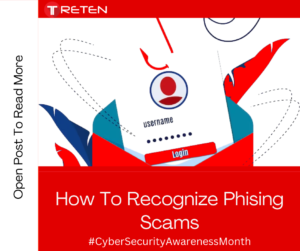
10 Foolproof Ways to Spot and Avoid Phishing Scams – Protect Yourself Online
Recognizing phishing scams is fundamental in the present digital age to shield yourself and your sensitive data from cybercriminals. To assist you with becoming adroit at recognizing phishing endeavors, we have compiled counsel from the absolute best cybersecurity specialists. Here is a comprehensive guide on the best way to recognize phishing scams:
1. Check the Sender’s Email Address:
Expert Tip: “Always scrutinize the sender’s email address. Phishers often use email addresses that mimic legitimate ones but contain small discrepancies.”
Action: Carefully examine the sender’s email address, looking for misspelled domains or unusual variations.
2. Look for Generic Greetings:
Expert Tip: “Phishing emails often use generic greetings like ‘Dear Customer’ or ‘Hello User.’ Legitimate organizations personalize their communications.”
Action: Be suspicious of emails that don’t address you by your name or use vague greetings.
3. Verify Links and URLs:
Expert Tip: “Hover over links before clicking. Check if the URL matches the legitimate website’s domain.”
Action: Hover your mouse pointer over links to preview the destination URL, and avoid clicking if it looks suspicious.
4. Beware of Urgent Requests:
Expert Tip: “Phishers create a sense of urgency. Be cautious of emails that demand immediate action, such as ‘your account will be suspended.'”
Action: Take your time to evaluate the situation. Legitimate organizations usually provide ample notice for important actions.
5. Examine Spelling and Grammar:
Expert Tip: “Phishing emails often contain spelling and grammar mistakes. Legitimate organizations maintain professional communication.”
Action: Be wary of emails with numerous errors, as they may indicate a phishing attempt.
6. Check for Unsolicited Attachments:
Expert Tip: “Avoid opening unexpected attachments, as they may contain malware or malicious code.”
Action: Only open attachments from trusted sources and, when in doubt, confirm with the sender.
7. Validate Requests for Personal Information:
Expert Tip: “Legitimate organizations rarely ask for sensitive information via email. Be cautious of requests for passwords, Social Security numbers, or financial details.”
Action: Contact the organization through official channels to confirm the request’s authenticity.
8. Scrutinize the Design and Branding:
Expert Tip: “Phishers often mimic the look of legitimate websites. Pay attention to design inconsistencies and logo quality.”
Action: Compare the email’s design and branding to the official website. Any discrepancies should raise suspicions.
9. Be Wary of Pop-Up Forms:
Expert Tip: “Avoid entering personal information into pop-up forms that appear in email messages. These are often phishing traps.”
Action: Close any pop-up forms in emails and go directly to the organization’s website to enter information if necessary.
10. Educate Yourself Continuously:
Expert Tip: “Stay updated on phishing tactics and cybersecurity best practices. Knowledge is your best defense.”
Action: Keep learning about new phishing techniques and evolving security threats to enhance your awareness.
10 Foolproof Ways to Spot and Avoid Phishing Scams – Protect Yourself Online
Remember that phishing scams can take various forms, so it’s vital to remain watchful and pay attention to your instincts. In the case of something appears to be not quite right, it’s smarter to be protected than sorry. Continuously report dubious messages to your organization’s IT department or the appropriate authorities to help with combatting cybercrime.
Contact Treten Networks Today to stay secured!

